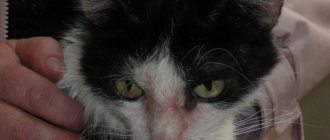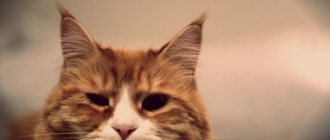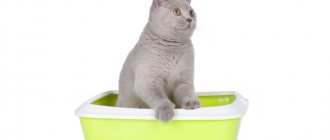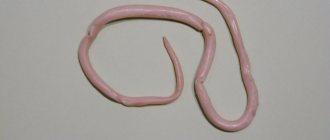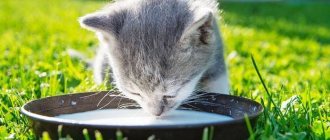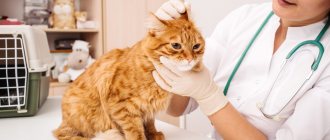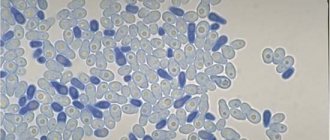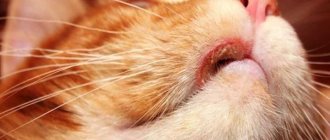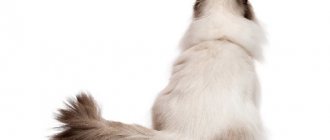Signs that a cat is wandering
A cat in heat causes a lot of trouble to its owners.
The average duration of a cat's heat is 5-7 days. There are also temperamental individuals that can walk for 10-14 days every month. The first time a cat begins to ask for a male cat is at the age of 6 months, but this is too early for mating.
The characteristic symptoms of estrus are immediately noticeable:
- friction of the pet against objects - often, for a long time;
- loud screams with inviting notes, often at night;
- more affectionate behavior with the owner and others;
- refusal of food (the cat may not even eat its favorite treats);
- frequent urination, especially if there is a cat nearby;
- when stroking the tail area, the animal protrudes its back part, twitches its tail, and bends its paws;
- clear fluid is discharged from the vagina.
Symptoms may vary between individuals. There are animals that walk almost unnoticed, and the owner finds out about the heat after pregnancy. But more often the first signs are pronounced.
Climate infertility
It may occur in response to a sudden change in climatic conditions, for example, when moving long distances. A significant role is played by the microclimate and atmosphere in the house where the cat lives. Unsanitary conditions, lack of light, heat or cold can lead to infertility.
Infertility in cats: causes and treatment methods.
Infertility in cats: causes and treatment methods.
Infertility in cats: causes and treatment methods.
Infertility in cats: causes and treatment methods.
Calm a cat at home
Experienced owners offer the following options for solving the problem of sexual hunting:
- lock the animal in a separate room (but this is not always suitable; often the cat experiences even more stress);
- during the period of activity, put the animal under water (preferably warm) for several minutes;
- distract your pet by playing: during the period of sexual activity, the cat experiences an excess of energy, which in nature it spends on searching for the cat and mating.
Be sure to read:
The cat won’t let the cat near: reasons, how to create conditions for mating, what to do if it doesn’t work out
These methods help if one or two heats need to be missed, and in the future the cat is going to be mated with a male.
Advice! If the offspring are not needed at all, then it is better to sterilize the animal, since long and constant abstinence negatively affects the overall health of the animal. The cat develops suppuration in the uterus, and pathologies of the reproductive system may develop.
Folk remedies
Herbal therapy is considered gentle and quite effective.
To calm a walking pet, people use:
- lemon balm;
- chamomile;
- mint;
- motherwort.
A decoction of these herbs, individually or as a complex, is given to the animal twice a day. These methods are considered the safest because they do not contain hormones. Hence the short duration of the impact.
Attention! If herbs are used too often, the animal becomes lethargic and apathetic.
Veterinary methods
If the offspring are not needed at all, then it is better to sterilize the animal.
If the animal is active and folk remedies do not help, veterinary drugs are used. They can act in different ways: change the animal’s hormonal levels, or simply have a calming effect.
The form of release of such medications is very diverse: tablets, injections, suspensions, decoctions and even drops. Many veterinary drugs have side effects, especially when taken chronically.
Before use, you must carefully read the instructions and consult your doctor.
Sedatives and medications
To calm a pet during estrus, veterinary medicine offers various medications.
The most popular means are:
- Kot Bayun is a water infusion of soothing herbs. Available in drops in bottles of 10-16 ml. The product is safe, has a calming and analgesic effect.
- Fospasim is a homeopathic medicine in drops. Helps your pet survive stress. It is used not only for calming while searching for a cat, but also when moving, before exhibitions and for easily excitable animals.
- Stop-intim is a hormonal drug that is recommended for use if you do not plan to get offspring from your cat.
- Stop-stress - effective drops of domestic production. Contains calming plant extracts & phenibut. The daily dose is 1 drop per 1 kg of weight. Divide into 2 doses.
Be sure to read:
A cat drags kittens, hides them and moves them to another place: reasons, what to do, what can happen
Hormonal medications provide high-quality results, but if the strict dosage is not followed, they are harmful to the pet’s health.
Acquired and artificial infertility in cats
Acquired infertility can be divided into two types: operational and nutritional. In the first case, the cat’s illness is associated with selfish and greedy people who try to get as many purebred kittens for sale from their pet as possible. In this case, the animal can bear offspring 2-3 times per year.
During the short period between pregnancies, the cat’s body does not have time to recover and gain strength. And as a result, with each subsequent time the offspring will be weaker and more painful, and the animal’s genitals will begin to ache and, over time, infertility will appear. Therefore, mating and childbirth should be carried out no more than once a year, in this case the cat will be healthy, as will her kittens.
Nutritional infertility is associated with a violation of the feeding system and the amount of food consumed by the animal. Veterinarians call this reason the most pressing in the modern world. With the advent of a large number of types of dry food, many of which, mainly from the cheap segment, are not of good quality and often contain dyes, flavors and other artificial impurities that negatively affect the animal’s body.
It is important to monitor not only the diet, but also the quantity and frequency of feeding.
In scientific laboratories, after several years of research, they found that a cat that is overweight or, conversely, that does not receive enough food cannot have offspring. The cat should be at its normal weight, that is, approximately within the breed standards. Also, your pet must receive the required amount of vitamins, minerals and trace elements for the normal functioning of the body.
Artificial infertility is a surgical intervention to stop the attraction and subsequent pregnancy of an animal. This procedure includes sterilization, which is carried out in almost every veterinary clinic after a preliminary examination of the cat. It is advisable to carry out this procedure for an animal at an early age, but after 1 year of life.
How often does heat occur?
After giving birth, some pets ask for a cat within a month and a half.
The first heat in cats occurs at the age of 6-7 months.
If the cat has already been in heat, then she walks once every three months. But an animal that didn’t have a cat walks more often. After giving birth, some pets ask for a cat within a month and a half.
How to determine the onset of estrus?
The process of “spring” in a cat is divided into three periods:
- proestrus;
- estrus;
- metestrus.
The beginning of estrus is proestrus. This period lasts 4 days. Already at this time, the cat’s genitals secrete a clear liquid, the cat is not yet accepting the cat, but external signs of hunting are present.
The first symptom of approaching heat is increased tenderness towards the owner and others.
How long does heat last?
Duration is on average 7 days. The older the animal, the longer the hunting period lasts.
Congenital and age-related infertility
With congenital infertility, problems in the animal’s body begin in the womb. Due to improper formation of the fetus, the genital organs do not develop fully. This is usually caused by defects in the male's sperm or female's eggs, inbreeding, or improper nutrition of the pregnant cat.
With congenital infertility, both male and female genital organs can form in one representative, so-called hermaphroditism.
The animal will never be able to have offspring and any therapeutic interventions will not bring results.
After the 8-year age barrier, the cat’s reproductive organs begin to weaken and after 2-3 years they completely lose their functionality. If the animal does not receive proper care and proper nutrition, then such processes begin earlier. Therefore, a properly balanced diet, caring care and kind attitude towards your pet are necessary.
To sterilize or not?
Sterilizing a cat is a cardinal method of solving a problem.
Sterilizing a cat is a cardinal method of solving a problem. Before you decide to have surgery, you need to think it over carefully. Doctors recommend that the procedure be carried out as early as possible for the health of the pet. A cat at a young age tolerates anesthesia more easily.
But the owner must remember that the operation changes the pet’s body irrevocably. This means that if you want to get offspring, there will be no opportunity for this.
At the same time, long-term abstinence for a cat is severe stress, which, in addition to nervous disorders, also leads to diseases of the reproductive organs. An unsterilized cat often suffers from ovarian cysts, purulent inflammation of the uterus, hormonal disorders, and tumors of the mammary glands.
Professional veterinary specialists agree that if you do not want to produce offspring from a cat in the future, then it is better to sterilize your pet . This will relieve the animal from stress during the hunting period, and will bring relief to the owner.
Be sure to read:
The cat went on a spree for the first time, yelling. What to do at home, how to calm down
Pros and cons of sterilization
Compared to other methods of controlling feline sexual activity, neutering has both advantages and disadvantages.
Advantages of sterilization:
- Solving the problem once and for all. This is actually a disadvantage too, since at one moment the owner may regret that the animal is not able to become pregnant.
- Efficiency 100%. Drops and tablets, even hormonal ones, may not work. It's very individual. The operation will give the desired result, without a doubt.
- The operation is safe. It is performed through a small incision on the side of the torso.
But the operation also has disadvantages:
- It takes time to recover. This is an abdominal operation that is performed under general anesthesia. After it, the cat may feel unwell for some time and be lethargic. The animal should not be fed for several hours before surgery.
- The operation costs money. Some owners find it cheaper to purchase drops or tablets once a month.
- Inability to obtain desired offspring in the future.
- Irreversible changes in the cat's body. Hormonal changes can cause your pet to become lethargic, less mobile, and have a tendency to gain weight. By organizing proper nutrition, the risks of disease are significantly reduced.
If your pet is fed prepared specialized food, then after sterilization you should purchase food for sterilized cats.
Psychological and hormonal problems
Most often, a cat cannot become pregnant due to a failure or absence of a cycle - anesthesia. This can be detected by the number of heats. A healthy individual during the breeding season has two heats with a pause of 2 weeks, but the duration of the break can be up to 30 days (depending on the age and breed of the cat).
If the pause is prolonged, this may be the first “bell” of problems with the cycle.
On a note!
Sometimes long breaks in estrus are associated with a lack of daylight. Examine the premises for compliance with pet keeping standards.
Another problem is the presence of hidden heat. We are talking about a condition when physiological estrus is present, but the animal tries to suppress all signs of this process, since it is not ready to reproduce. The cause often lies in the pet's character - it often affects shy animals or pets that have been exposed to a lot of stress.



